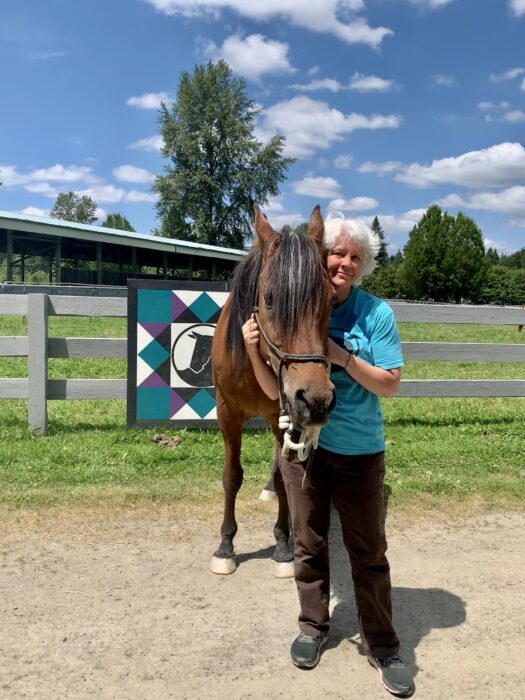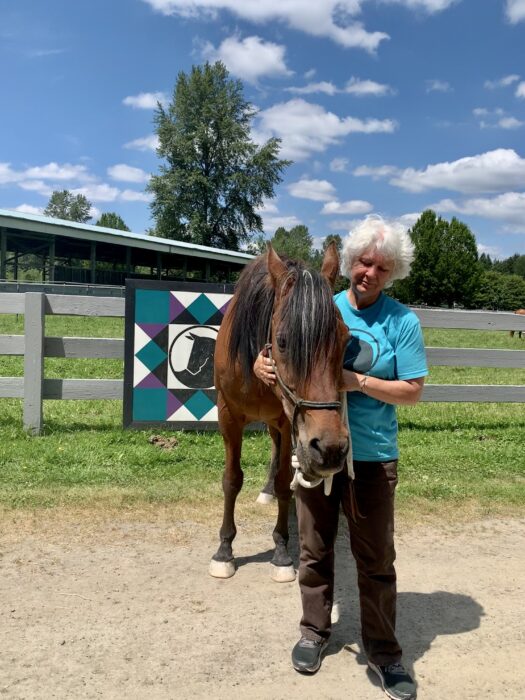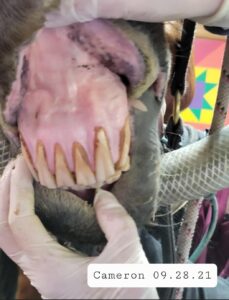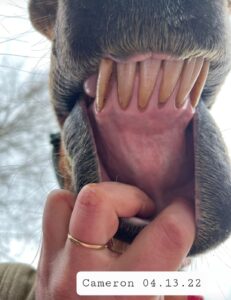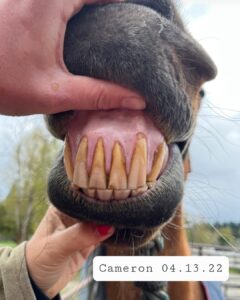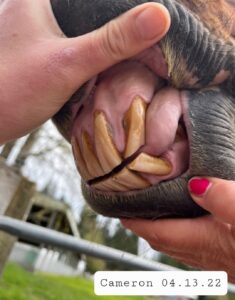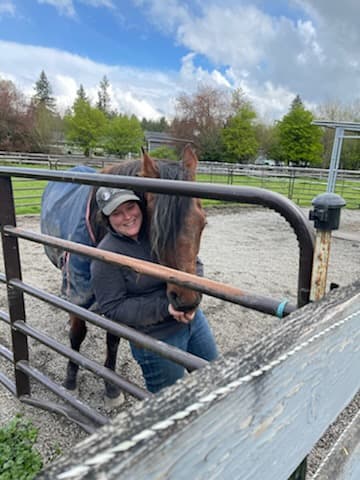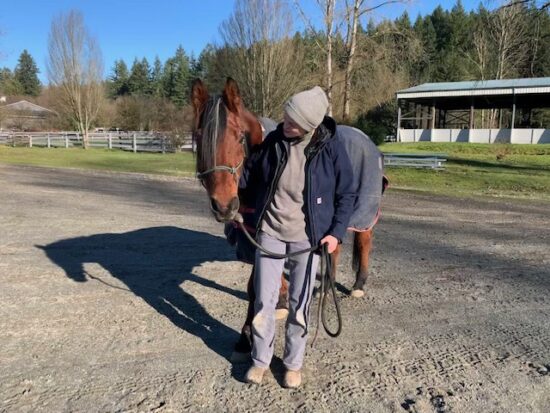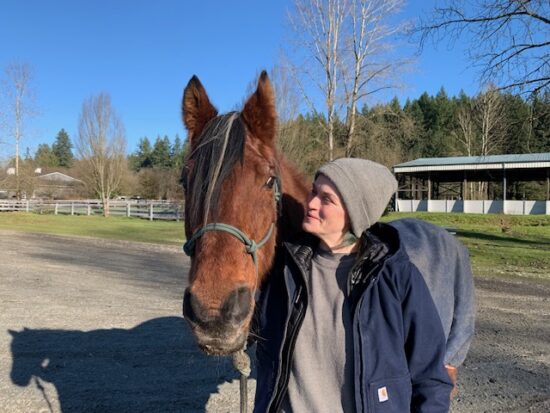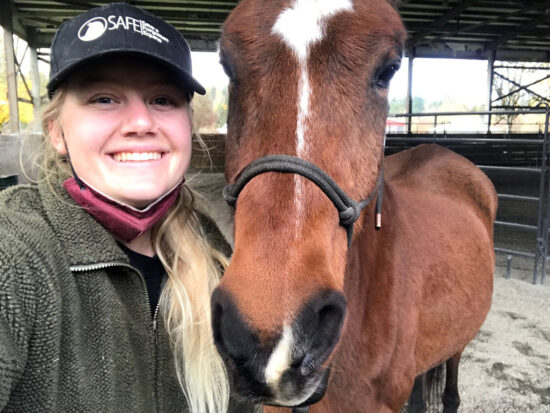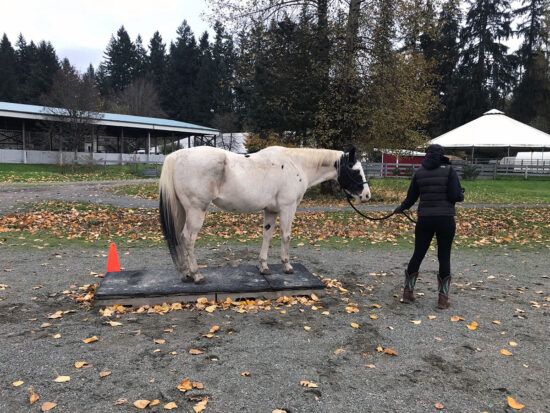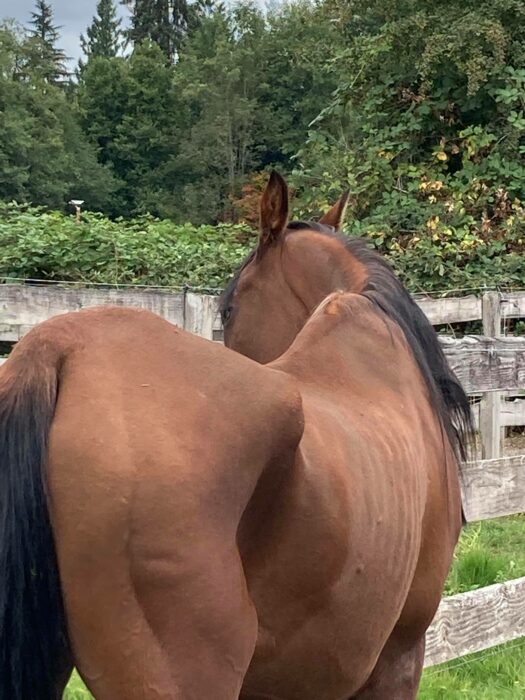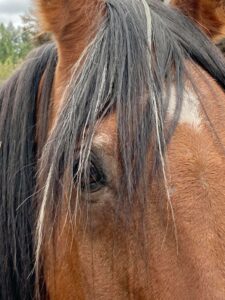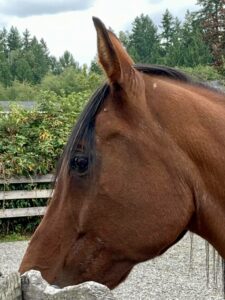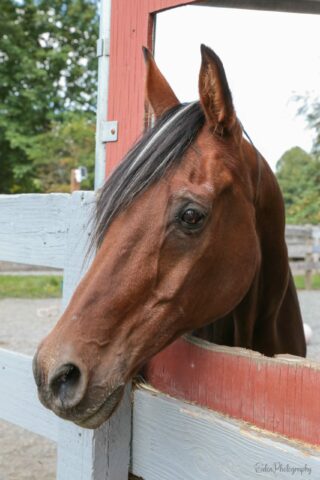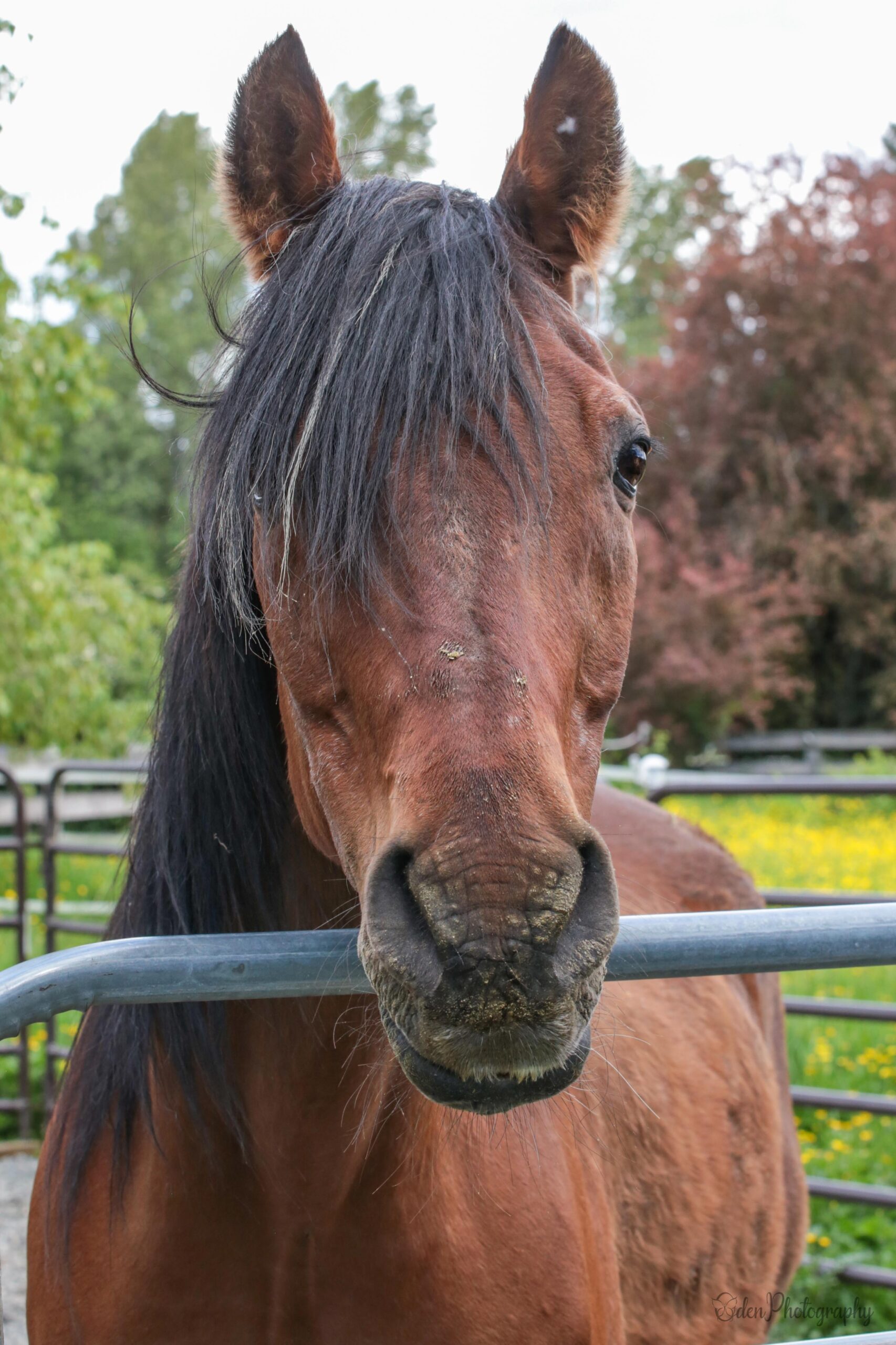Cameron
1991 bay Arabian gelding
Registered Name: MWF Cameron
Type of Rescue: Owner Surrender
Intake Date: 8/20/2021
Date of Passing: 11/17/2022
Length of Time with SAFE: 1 year, 2 months
Cameron was very popular and beloved to our volunteers, who signed up to take turns hand walking him around the property and grooming him. He was with us for a very good year, but at age 31, and with the extensive neglect he suffered, his health began to decline. He had a few troubling bouts of colic, and then one day in November 2022, we noticed he him walking unsteadily. He seemed to be unweighting his left hind and dropping his right hind pastern. He had bounding pulses in both hind legs and his heart rate was 80 bpm, indicating a high degree of pain. Part of the reason for his failing ligaments might have been the steroids he was given to help him move his bowels. We knew that medication was necessary palliative care that would ultimately shorten his days. So Cameron was laid to rest on a beautiful late fall day, surrounded by friends wishing him a safe and peaceful passing. Cameron was a sweet and dignified old man, and it was our great privilege and honor to care for him at the end of his life.
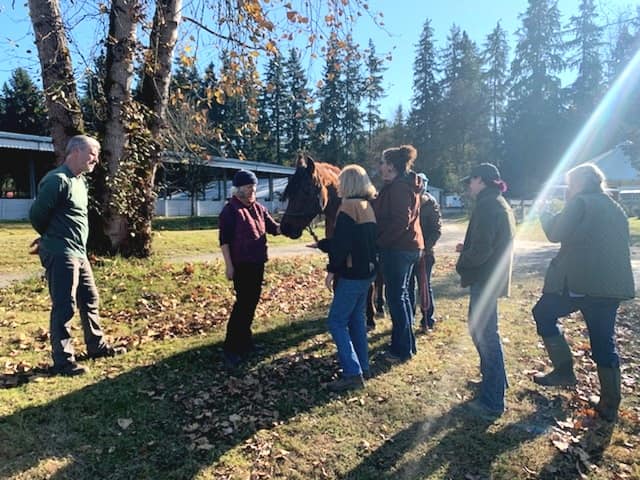
Goodbye, dear Cameron
We lost our dear Cameron today. We noticed he was not walking steadily, and was unweighting his left hind and dropping his right hind pastern. He had bounding pulses in both hind legs and his heart rate was at 70 bpm. When Dr Renner arrived, it had increased to 80s (double normal range). He was in a grave amount of pain that we could not control and it was determined he would continue to suffer if we did not act quickly. Part of the reason for his failing ligaments might have been the steroids he was given to help him move his bowels. We knew that medication was necessary palliative care that would ultimately shorten his days.
These decisions are the absolute hardest part of horse ownership. There are a few things that help ease the heartache. After a year here with SAFE, he was at a perfect weight, he enjoyed yummy mash meals around the clock. He had loving friends and received excellent medical care from Rainland Farm Equine Clinic, with both Dr Lewis and Dr Renner making multiple visits any time he showed discomfort and staff and volunteers watching over him.
Cameron had some of his best days here at SAFE. He had the best team of groomers and walkers a guy could ask for, visiting him daily and help him thrive here. Debbie, Lisa, Joan, Monique, Trela, Amy, Mirella, Sundee,
Jan, Sam, and Carrie. You all made his days at SAFE filled with love and kindness. Thank you from all of us for your special friendship with Cameron.
We said goodbye to Cam on a beautiful sunny day. He was surrounded with love and felt the warm sun on his back. Today is a hard day, but it isn’t a bad one. He is free and will never be forgotten.
We would not have caught his pain as quickly as we did if it was not for our attentive volunteer, Joan, who noticed something was not right. Kaya quickly got vitals and had Dr Renner on his within minutes. We are comforted knowing he did not suffer long and that he knew love, dignity and respect on his last days.
Rest in Peace, MWF Cameron April 25, 1991- November 17, 2022
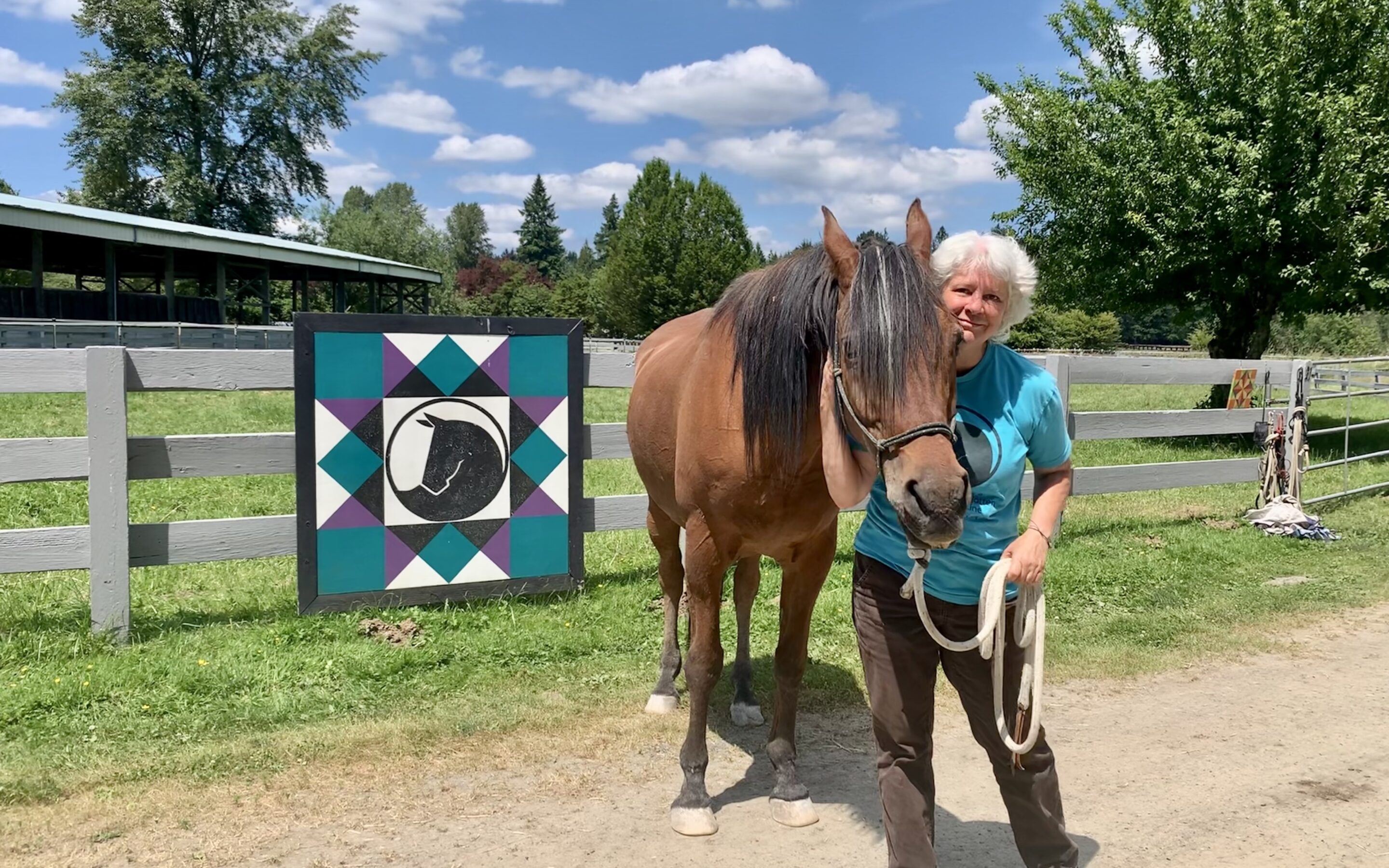
A Walk With Cameron
One of our long time volunteers, Monique, who walks Cameron once a week, wrote this about him and it melted our hearts.
“Our sweet boy Cameron can see us a mile away, Is that a bucket?! Oh, time for my walk! He’s always eager against the gate, messy face nose dive in halter. Um, let’s check out the new kids, look Cameron a new cute mare! Swoop! Head dive for road hay-pull up, our dance as we walk in companionable silence with the occasional tripping his or mine. We get into a rhythm Cameron and I, looping around the long road to spooky back barn lane, “I’m not spooky!” he says, even with the barn cats darting pass. Eventually we’ll end up at Lacey Lane for a quick grass munch, sorry Lacey.
OOWWEEE, that grass taste good as Cameron’s pace slows down, limbs warmer, back stretched for another lazy eight loop. Clip clop, what a beautiful boy he is, content and always alert, his youthful magnificence shining through. Back in his paddock, a little neck rub, he must think he won the lottery coming here to SAFE, hope he knows I feel the same.”
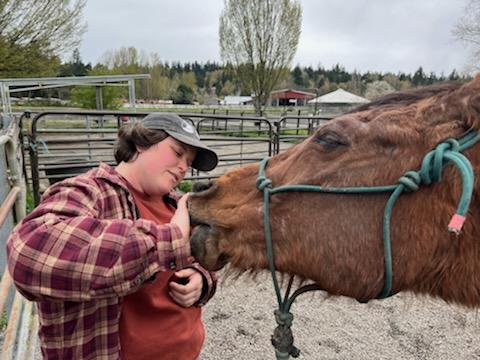
Mouthy Man Cam
Careful observation is always a good thing!
A few folks grooming and walking Cameron have noticed him doing some funny things with his face. He would push his lips at the gate with his blanket on it and even at their hand when they were near his face. He would also lay all his head weight in their hands. Being the careful observers that they are, this was reported to the staff for further investigation.
A little back story, last fall during Cameron’s dental, Dr. Lewis detected the early signs of EOTRH. At the time he appeared to have a very mild start of the disease and no painful symptoms. We were told to keep an eye on it and report any painful behavior, sores or advancing of the tooth lesions.
What is EOTRH you ask? “Equine Odontoclastic Tooth Resorption and Hypercementosis, also known as EOTRH, is a syndrome in horses that results in resorptive lesions of the incisors and sometimes canine teeth. It is usually gradual in onset, though often isn’t diagnosed until quite extensive lesions are present.” From article: EOTRH Syndrome | Midwest Veterinary Dental Services (midwestvetdental.com)
Cameron will continue to have annual dental checks (due in September) which may not include much of a dental float due to his “worn out” teeth. He has some teeth missing and a significant wave in his teeth. Unfortunately, at his advanced age nothing can be done to correct the wave because if we take too much tooth away it will kill the entire tooth. If the EOTRH advances to a painful stage, shows signs of pain or discomfort, we may be able to put him on anti-inflammatory medication or consider removal of the painful teeth. However, since he is on daily steroids from his muscle loss in his rectum, we would be very careful with adding any other medications and only do this with our veterinarian’s approval. Since he is on a low dose of daily steroids we are monitoring his kidney and liver functions. Just last week we rechecked these levels and did an ATCH test to make sure he is not showing any signs of Cushing’s. Thankfully all is in good order and he is currently okay to continue on his medication treatment.
We sent current photos of his teeth and gum condition to Dr. Lewis to compare them to last fall’s photo. They look similar and without any significant irritation or sores.
Given what the staff observed we do not think his behavior is a painful symptom of the EOTRH. These “funny behaviors” are seen when he is being groomed or having his Masterson’s massage treatments. He appears to be exhibiting these behaviors in response to feeling good. It may be a form of reciprocal grooming, where horses mimic the grooming they would give to other horses if they were getting whither or neck itches. Also, some horses like the upper gums pushed on and rubbed.
After looking at the photos and talking with us, Dr. Lewis agreed: “rubbing his teeth on things in response to stimulation like massage or grooming, I’m inclined to agree with you that it’s just him saying it feels good. The signs of dental pain we see with EOTRH tend to be things like not wanting to bite hard horse treats/carrots or more generalized signs of pain like withdrawn, quiet and less social.” Luckily, Cameron is VERY social and appears to be living his BEST life since coming into SAFE.
We are all very grateful for the careful observations and communication from volunteers at SAFE. Small things like this can help put together a full picture of health for our horses, help us catch issues early and we appreciate it! Cameron is a sweet goober with many adoring fans here at SAFE. He gets tons of love and doting over him which we all agree he deserves! Thank you all for supporting horses like Cameron through your donations and sharing SAFE with your friends.
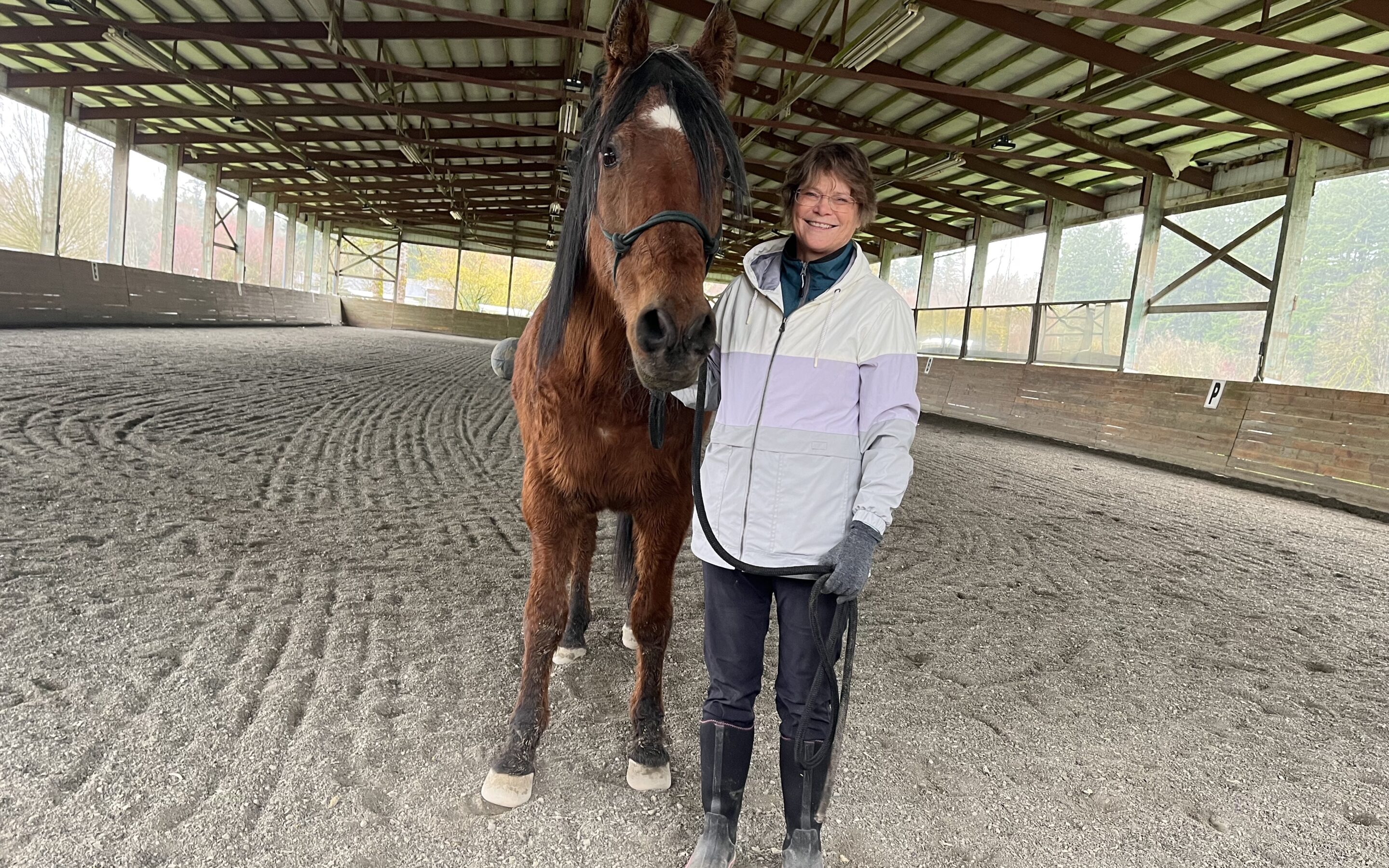
Cameron and Carrie
Here is an update on Cameron from one of our volunteers, Carrie S:
“This is the magic of SAFE. A sweet old pointy Cameron is now a dashing debonair gelding full of life and showing his stuff. I took him out for his daily walk yesterday and he was simply dancing and prancing. Kaya gave permission to turn him out for a romp in the round pen without his blanket so he could roll and play. As soon as the halter came off he bucked and farted and galloped. I was astonished to see all of his muscles!! Look at that rump and those hips. He’s a solid, happy 30 year old with tons of life left in him. I wish I could see pics of him at 10 years old. Such a handsome boy who can still float above the ground. Thank you SAFE for giving this sweet boy a second chance. He’s a love bug.”
Check out the video Carrie took of Cameron. He loves to kick up his heels!

Cameron Enjoys Long Walks
We have a few volunteers who come once a week to give our gentleman Cameron a walk around the property. Here is what Meghan Nicolson had to say:
“Walking with Cameron is a highlight of my week! When we first started walking together he just wanted to go, with his long/fast strides; but it didn’t take long before Cameron learned to slow down to my pace. He is very aware of everyone/everything at the farm, and you can see his curiosity as we walk by. Cameron is trusting, sweet, and gentle, always willing to try something new. While he prefers me to walk on his left, he is getting more and more comfortable when I switch to his right side (just make sure to move the hair from his eyes). Cameron keeps me laughing as he is a gentle opportunist; hoping to get a bite of grass or fallen hay in the roadway. But he is always happy at the end of our walk when he returns to his paddock and gets to finish licking his lunch bowl clean.”
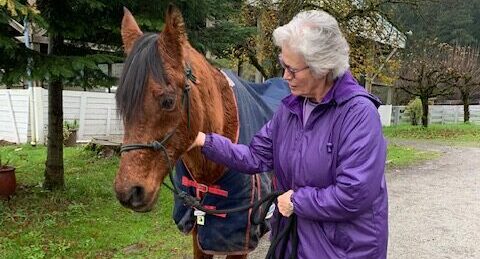
Cam, My Man
A Horse of Many Names …
Cameron, Cam, Cam My Man … these are all the names by which he is lovingly referred. As you may recall from an earlier update, Cameron has been participating in the SAFE Handwalking Program since last October. The program was developed to accommodate the need for the SAFE horses to stay active, especially those recovering from some mishap or those companion horses who do not get regular stimulation through the SAFE Horsemanship Program as they are readied to become adoptable riding horses. As a result, Cameron has a harem of SAFE volunteers (aka Admirers) who met the criteria for the SAFE Handwalking Program, wanted to practice their horse leading and handling skills and committed to walk him for 30-minute intervals during their assigned day and scheduled slot each week. Following is what one of those Admirers, Debbie M, has to say about her time with Cam …
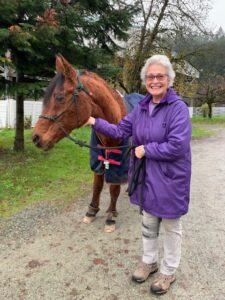 What a special boy Cam is and smart, too! While he would prefer to take the lead as evidenced by his tendency to forward walk if being led on his left side, he usually will back up on his own when I stop to first ask him to do so and always if a second ask is needed or on the rare occasion when he needs to be asked a third time. He obviously is more accustomed to being walked on this left side and seems to be more comfortable with his handler being on that side. However, he is adapting quite nicely to being led on his right side, too, so we spend time doing both on our walks for more mental stimulation. For variety, we walk the main loop between the barn and around the outdoor covered arena; traverse the open arena in multiple directions; spend time in the covered arena; and on occasion, meander to the back paddocks so we can say “Howdy!” to all the horses who come to their fence lines to observe us enjoying our walk. As with most horses, grass is quite tempting; but he accepts the fact with minimal resistance that he is not allowed to munch on any during our walks. It is as if he knows munching on grass may not be good for his tummy … or at least I would like to think so! Always the gentleman, Cameron will lower his head and guide his nose into the halter for the start of our walk and patiently wait for his halter to be removed at the end of the walk … unless the SAFE “food truck” is delivering a meal to his neighbors and he knows his paddock soon will be visited! Cam is My Man on our weekly walks. I sincerely appreciate his patience with me and what he is teaching me and thoroughly enjoy spending time with him. On behalf of all of his Admirers … Thank you to SAFE Management for giving us this opportunity.
What a special boy Cam is and smart, too! While he would prefer to take the lead as evidenced by his tendency to forward walk if being led on his left side, he usually will back up on his own when I stop to first ask him to do so and always if a second ask is needed or on the rare occasion when he needs to be asked a third time. He obviously is more accustomed to being walked on this left side and seems to be more comfortable with his handler being on that side. However, he is adapting quite nicely to being led on his right side, too, so we spend time doing both on our walks for more mental stimulation. For variety, we walk the main loop between the barn and around the outdoor covered arena; traverse the open arena in multiple directions; spend time in the covered arena; and on occasion, meander to the back paddocks so we can say “Howdy!” to all the horses who come to their fence lines to observe us enjoying our walk. As with most horses, grass is quite tempting; but he accepts the fact with minimal resistance that he is not allowed to munch on any during our walks. It is as if he knows munching on grass may not be good for his tummy … or at least I would like to think so! Always the gentleman, Cameron will lower his head and guide his nose into the halter for the start of our walk and patiently wait for his halter to be removed at the end of the walk … unless the SAFE “food truck” is delivering a meal to his neighbors and he knows his paddock soon will be visited! Cam is My Man on our weekly walks. I sincerely appreciate his patience with me and what he is teaching me and thoroughly enjoy spending time with him. On behalf of all of his Admirers … Thank you to SAFE Management for giving us this opportunity.
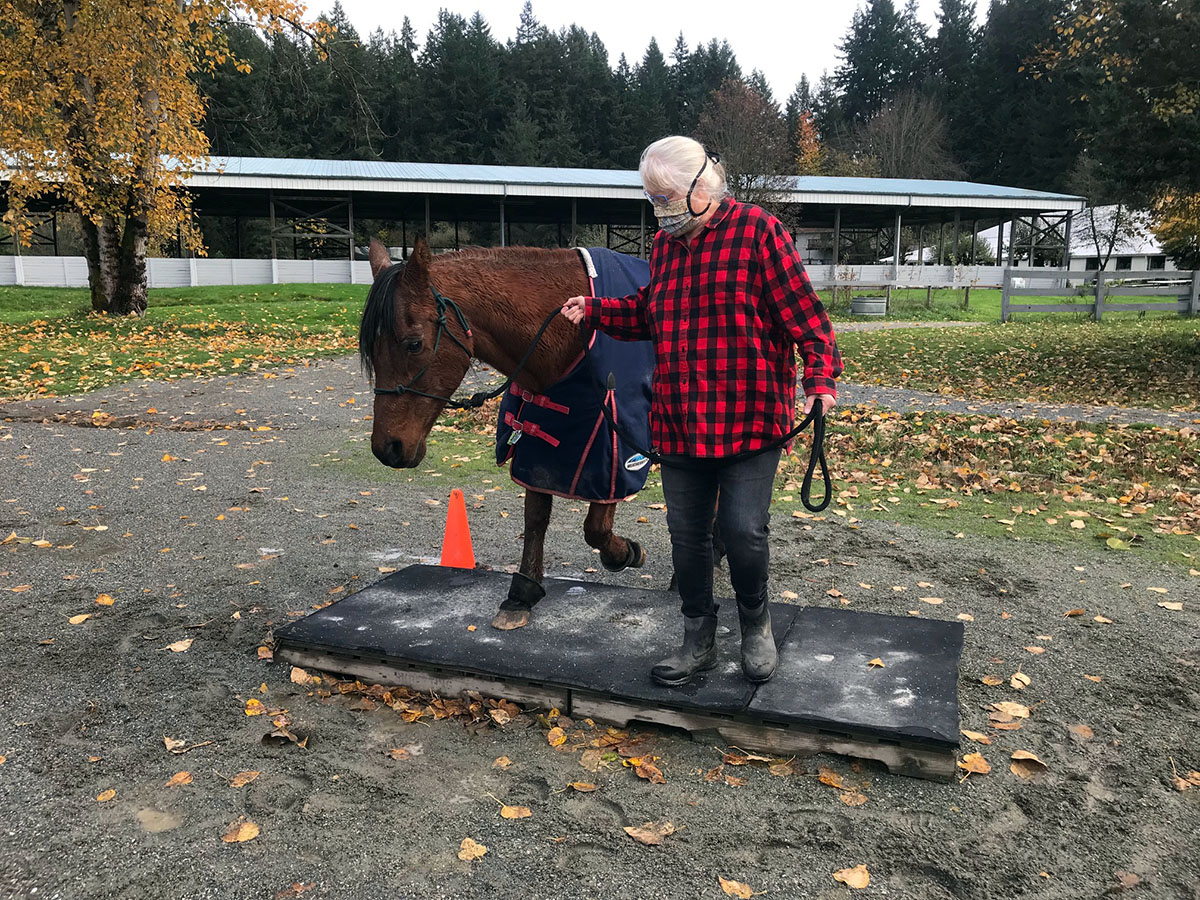
Taking A Walk On The (not so wild) Side
When many imagine an active horse, they envision great feats of athleticism: horses cavorting around courses and launching themselves over jumps taller than children, horses dancing around arenas with grace and finesse, horses racing around barrels with speeds reaching mach 1. They might not picture a horse on a leisurely stroll, with no saddle, bridle, or rider, merely a human friend to walk side-by-side with.
But this very image is the reality for some of our horses here at SAFE, who have been enjoying guided tours around the property. The idea was born from a need for our horses to stay active, especially as we head into the cold rainy season. It also provides an opportunity for interested volunteers to practice their leading and handling skills.
Spearheading the program are Mac, Domino, and Cameron. It just happens that the three are gentlemen of a certain age, which makes them the ideal candidates for some gentle walking. Keeping horses, especially older ones, mobile by hand walking them helps ensure they retain muscle without putting them through strenuous exercise. It also provides a little break in the routine of their days, and the three do seem to enjoy their outings.
Cameron is quite the gentleman when it comes to being haltered, lowering his head and doing his very best to help guide his own nose into the halter. It’s pretty apparent that this is not his first (or second, or third..) rodeo. For an older guy, he is still quite forward at the walk, but this is really his only vice, if you can even call it that. There is a focused determination to his strides, and it really feels like he is taking it all in, but never in a nervous way, merely an interested one. On occasion he will try to dive for a bite of grass or a bit of dropped hay, and while this is quite a mischievous move, it’s one that speaks to how chipper he’s feeling. Gone is the thin shell of a horse who arrived, replaced with a robust (and much more filled-out) gelding. Occasionally, a stop on Cameron’s walks involves a trip to the round pen, where his blanket is removed and he is turned loose for a period. Within seconds of being released, he goes down for a roll, and occasionally even kicks up his heels, running and bucking around like a colt. But when it is time to come in, he is always easy to catch back up, and stands patiently as he is re-dressed in his blanket. The only time he ever shows impatience is when there is food waiting for him, but even then he merely expresses his impatience with a slight tug towards his dish — excuse me human, I believe my lunch is here.
Domino is always waiting at the gate when you walk up, his velveteen head just begging for a pet. While he does make a slight beeline towards the barn as he comes down the hill (a man on a bit of a mission towards food), he is rather easily course corrected. He is a very pleasant walking companion, and will even allow you to lead him over the little pallet bridge we have set up in the outdoor arena. He definitely prefers a leisurely pace, but is a responsive participant, and is a friend to all who meet him.
Mac’s leg is healing nicely, and certainly not preventing him from enjoying the (sometimes) beautiful outdoors. Because of his pull back risk, he is a staff only horse to lead, which means that Mac and I have spent a lot of time together walking alongside his buddy Domino. Mac is a wonderful walking companion, always very responsive to what I’m asking of him, and quite good at acting as a model for demonstrating.
With fall in full force now, the weather lives in a state of constant unpredictability, but these three boys take it all in stride. Wind, rain, sun — they remain unfazed. They really are the very definition of a pleasure to have in class.
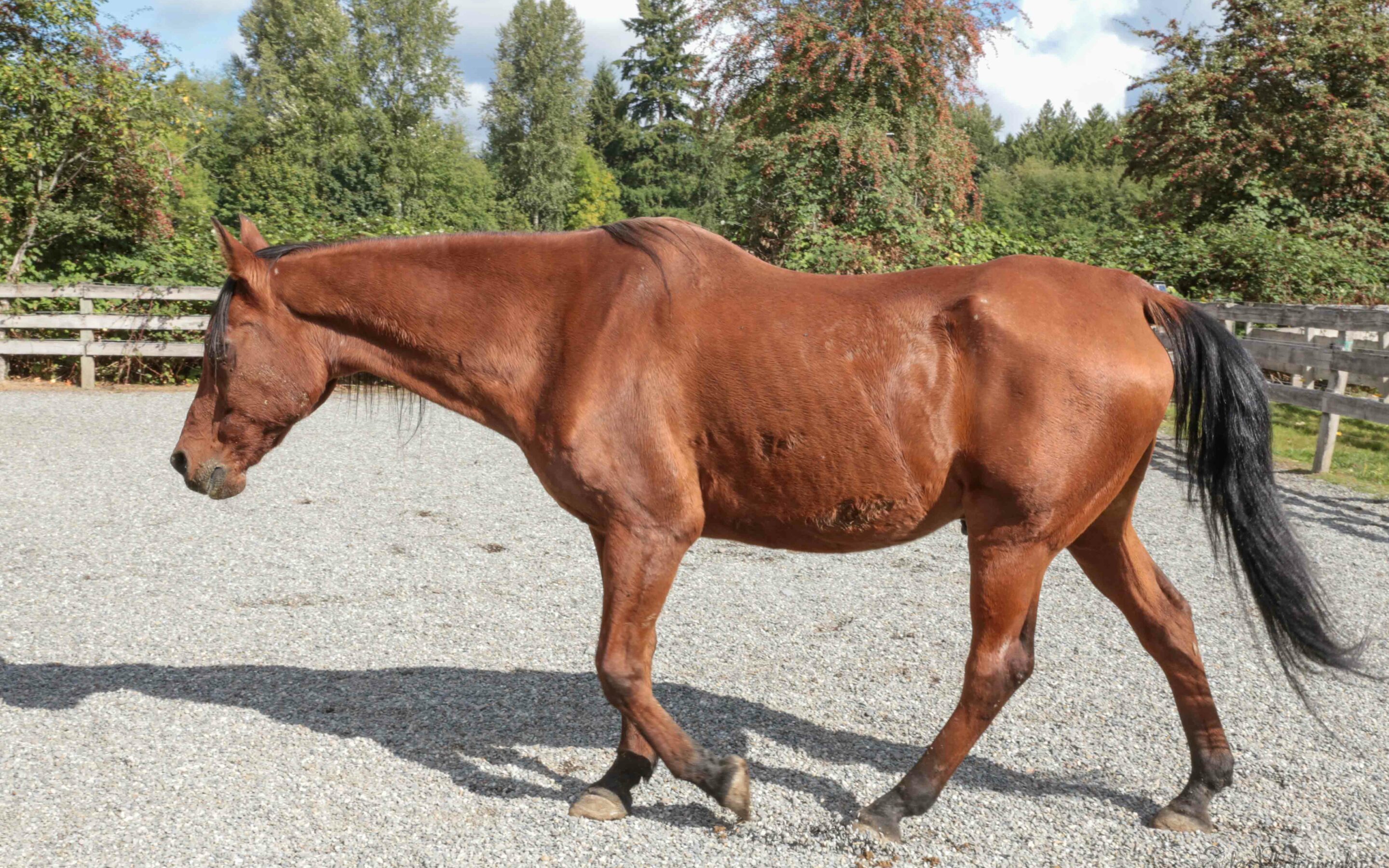
Cameron’s Rehab Progress
Cameron has settled into SAFE well. We were initially concerned about Cameron’s colon function, and after several weeks of close monitoring now have a feel for his typical manure production. He gets an all-mash diet of Haystack and senior grain which he eats with gusto. His weight has increased from 945 pounds to 988 pounds, and he is slowly starting to fill out.
Cameron saw the vet recently for a dental examination and float. Unsurprisingly, we discovered that he is missing a lot of teeth. He also has significant wave mouth, which means that he has a vertical misalignment of the molars when his jaws come together. This causes some of his molars to become longer than the adjacent ones which wears down the opposing teeth, sometimes to gum level. This results in a jaw which is less able to grind food and move it to the back of the mouth, which hampers his ability to process and digest the food as easily, leading to possible weight loss, colic, or choke. Dental work must be done very carefully so that the teeth aren’t filed down too much to make the horse sensitive while eating or expose the tooth pulp. Cameron’s teeth are in the early stage of EOTRH (equine odontoclastic tooth resorption and hypercementosis). This is an inflammatory process in which the roots of the incisors (and sometimes the canines) reabsorb or basically dissolve. Long story short: Cameron doesn’t have great teeth, and neglect has made them worse.
Because of the number of medical issues Cameron has, he will need a very special adopter who is experienced with senior horses. If such an adopter doesn’t come along, SAFE will ensure the best quality of life for Cameron. He is currently bright eyed and happy. He is hand walked once or twice daily. Cameron enjoys these strolls, likes attention, and is groomed multiple times during the week. Winter can change things a lot for a senior horse, so we will continue to closely monitor Cameron as the weather becomes more challenging.
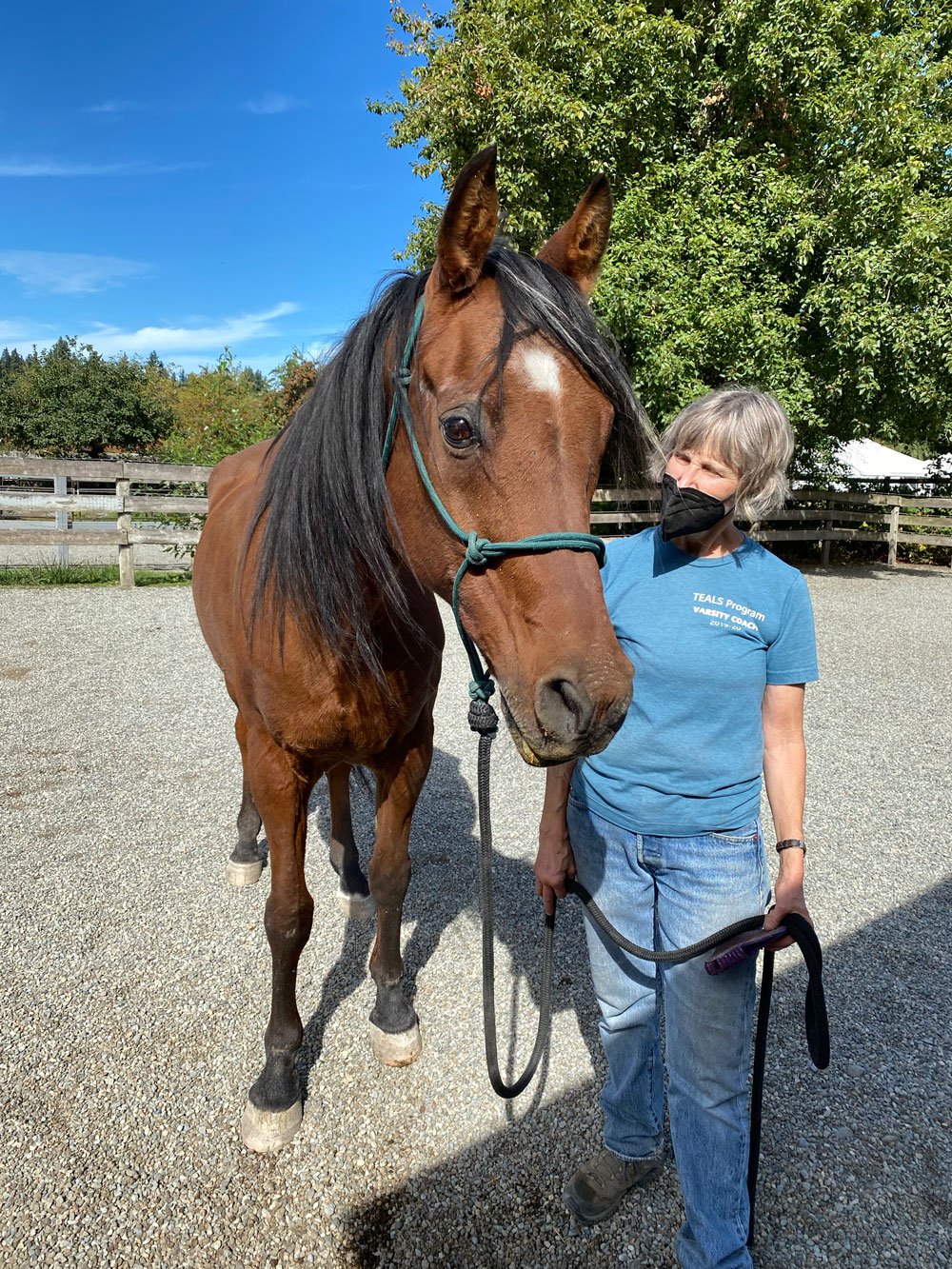
Our Man Cam
Cameron continues to thrive here at SAFE, and seems pretty happy and content to be part of our herd. We’re happy to report that his all-mash diet of Haystack and senior grain seems to be working: he’s polishing off every meal and licking the bowl; and best of all, he’s producing good poop right on schedule. Because of our concern about Cameron’s colon function, we’ve asked our volunteers to count his poop piles when cleaning his pen, and track them on a white board outside his gate. Safe to say we have the most patient and tolerant volunteers in the world here at SAFE! They’re doing an excellent job helping us to monitor his output.
Cameron is now being handwalked around the property by volunteers every day, and he looks forward to this outing quite a lot. He greets everyone who approaches his paddock with a sweet nicker, and he remains bright and interested in the horses that live on both sides of him. He’s a perfect gentleman for all of our requests. He got his hooves trimmed last week, and stood perfectly for the farrier. He’s shown some sensitivity when being haltered or fly masked, and we haven’t quite identified where it is he prefers not to be touched, but even when he’s triggered, he is kind enough to move away rather than jumping on top of his handler. He really seems to enjoy being groomed, which is not too surprising: gentle grooming can be quite soothing to a horse, especially one that has lived in isolation like Cameron was before coming to SAFE.
It’s going to take some time to restore Cameron’s weight to where it needs to be, but we’re definitely on the right track. His hips and spine are still quite prominent, but his coat is starting to show a tiny bit of a healthy glow. His energy is certainly better. All in all, our man Cameron is getting better all the time, which is what we love to see!
Cameron Arrives
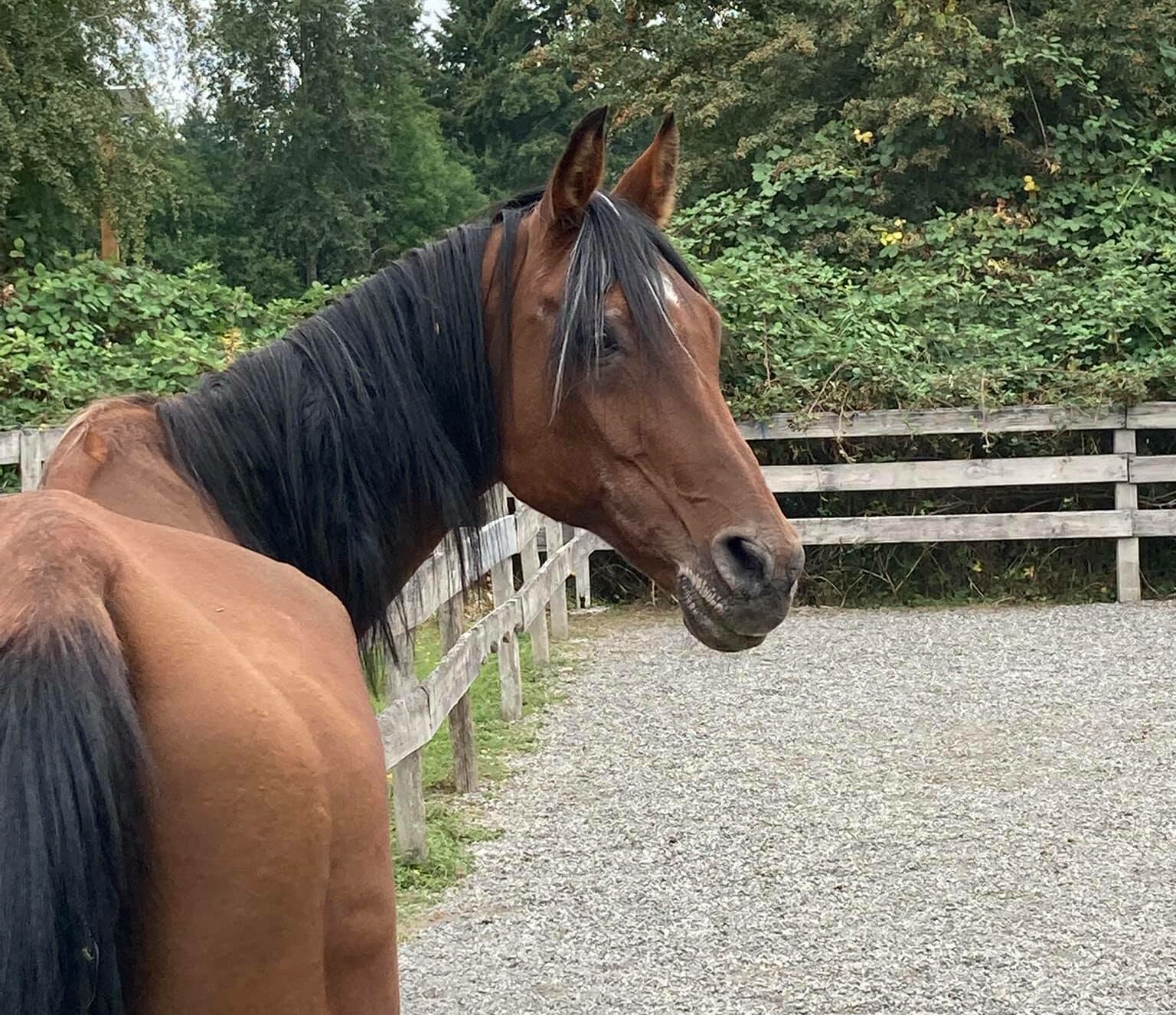
Introducing Cameron
When Cameron unloaded from the trailer at SAFE last Friday afternoon, we got our first good look at a horse who desperately needed our help. This 30 year old registered Arabian gelding has come to us in very poor shape. His hip points and croup are clearly visible because he is so severely emaciated. Photos do not often show the full extent of a horse that’s been starved, but the image to the right gives you a fair idea of how thin he is. Despite his condition, Cameron is a sweet old gentleman with a surprising spark of life in his eyes. He seems very happy to be at SAFE where he can see other horses, and where food comes often and on schedule.
Cameron’s story is a sad one for everyone involved. His owner passed away three years ago, leaving him in the care of her husband, who was inexperienced with horses, and unable to recognize that the horse’s health was declining. Horse ownership can be extremely challenging, even for those who take it on with enthusiasm. While Cameron’s family genuinely cared about him, they did not have the skills or experience to care for him. Horses need regular vet care and checkups, and that need only increases as a horse gets older. Had Cameron been seen by a vet on even an annual basis, his declining condition might have been noticed sooner. As horses age, they need dental care to ensure they can still chew their hay and receive all the nutrition and calories it contains. They need farrier care to ensure that their hooves stay sound and comfortable. And they need to be observed carefully for changes in behavior or attitude, changes in eating habits, changes in manure production, changes in muscle tone and coat health, changes in soundness and freedom of movement…these are just a few of the changes that horses face as they grow old. Elderly horses, when cared for correctly, should not look unhealthy or bony or thin.
Cameron is facing some physical challenges, and at this point, we cannot say for certain that we will be able to provide him with a good quality of life. He is extremely emaciated, and he has a systolic heart murmur. He also shows some neurological problems in his hind end. This not only affects his movement behind; he’s also shown difficulty when trying to pee or poop. On his second day at SAFE, we noticed a lack of manure in his paddock, and had Dr Lewis from Rainland Farm Equine Vet examine him for a second time that day. She sedated him, and was able to pull about a day’s worth of manure from his colon — perfectly good manure that was just sitting in his system because he lacks the muscle tone to easily push it out. Because of this, Cameron is now being fed a diet of pelleted feed in a wet mash several times a day to prevent refeeding syndrome, and no hay allowed. Our hope is that this will make it easier for him to pass manure.
If Cameron’s physical issues do not improve, we may have to take a serious look at his quality of life, and possibly make a tough decision on his behalf. We want nothing more than to give him at least a happy summer where he can enjoy good food, horse friends, and people that love and care for him. He deserves that much. We’re going to do everything we can to keep him comfortable but we will not let this grand old horse suffer.
Thank you to volunteer Lise A for these photos of Cameron.

